If you’re here from Asenshi or elsewhere, welcome. There is no tl;dr. Good luck.
Part 2 is here.
This is a rewriting of the information I gathered over the course of two and a half months in preparation for a panel I hosted at Anime Boston 2016 (click to watch). I invested my time in watching or rewatching 12 series, over a course of 213 episodes, which totals about 82 hours of straight anime, plus the time I spent taking notes during each episode which is another 30-40 hours, plus the time to collate, interpret, and format the data which is another 20-30 hours. I have detailed notes of almost every episode of every single original series Okada has ever written (full disclosure: not M3, Aquarion EVOL, or Gundam). I’ve had no less than half a dozen dreams about how I would never finish this in time and fail once I got to the con, and each one showed a unique way to fail. I now present to you the results of my research.
I love Okada Mari. And her writing too, of course. Seeing her name on the staff list is often a surefire way to know you’re in for a good show. But when asked why I liked her so much, I could only really answer that I found her characters and their interactions realistic, and maybe give a couple examples. Professional critics hardly helped by only saying things like her writing was “delicate” and her characters subtle (or perhaps more in the interviews I didn’t have time to translate). There was obviously something deeper in her style that clicked with me every time, and I wanted to find out what that was so I could share it with others. There must be a reason she’s won awards for her work, and keeps on being entrusted with the foundations of all these anime, even being called the most prolific anime writer of our time. When I started watching her anime for this, I had no idea what I’d find, if anything at all. Fortunately, my fears were for naught, as I could’ve easily spent twice the amount of time I did talking about her, and that’s without going into individual series and explaining why specific events happen in them. The series I took information from are as follows:
Sasami: Magical Girls Club (2006)**
True Tears (2008)
Canaan (2009)**
Fractale (2011)
Ano Hana (2011)**
Hanasaku Iroha (2011)
Aquarion EVOL (2012)
Black Rock Shooter TV (2012)**
AKB0048 (2012-13)**
Nagi no Asu Kara (2013)
selector infected/spread Wixoss (2014)
M3 – the dark metal (2014)
Gundam: Iron-blooded Orphans (2015-16)
**All episode scripts
These were all series that 1) Were completely original stories, and 2) Okada did the series composition for, as well as several if not all the episode scripts. What does that mean?
Very simplified, the Director is the head of the anime, and decides what direction to take everything as well as oversees all parts of production (this task is also passed down to Episode Directors for individual episodes, although they simply do as the Director instructs, and don’t necessarily have creative input*). The Director discusses the overall story with the Series Composition writer, who decides the flow for what goes in each episode, as well as all the key plot points and scenes. This is passed down to the Scriptwriter, who writes what is more commonly known in English as the “screenplay”. This includes not just the 300-400 lines spoken in each episode, but who is in each scene, what they’re doing and look like, how they’re acting, what the setting is, and so on. After several revisions with the Director and such, the final script is passed down to the Storyboarder who puts it all into visuals, which then goes on to the rest of the team (a thorough explanation of the other roles can be found here, here, or here). So, Okada does series composition and scripts, and often is in charge of other scriptwriters as well. Finally we can get to my findings. Keep in mind that I won’t be giving exhaustive examples; you can easily find them if you watch any of the anime listed above.
5/6/16 Update: I underestimated the Episode Director’s influence on individual episodes, but I can’t find the exact post about it. Pretty sure it’s somewhere in here. In any case it doesn’t affect the rest of this, just a small side note.
No Misunderstandings
The first point is perhaps the most important, especially considering how common misunderstandings are in anime. You will find none of them in her stories. Any potential misunderstanding is immediately shut down by any and all nearby characters, as if they have a medical aversion to them.
![[Underwater-Vivid] Nagi no Asukara - 04 (720p) [29E13057].mkv_snapshot_08.41_[2016.03.14_22.01.41]](http://mezashite.net/wp-content/uploads/2016/04/Underwater-Vivid-Nagi-no-Asukara-04-720p-29E13057.mkv_snapshot_08.41_2016.03.14_22.01.41.jpg)
For the record, Hikari actually wasn’t misunderstanding them, he was just lashing out. Even Tsumugu is just taking precautions, not misunderstanding Hikari
Honesty of Emotion
Characters in her stories will be incredibly, almost idealistically honest to each other about their feelings. They will spill out the deepest contents of their hearts, admitting their love or hatred, sharing their secrets, and holding nothing back when a friend or enemy has done something wrong. In fact, one of Okada’s greatest strengths is in being able to write conflicts and resolutions with conversations grounded in reality, and not rely on fighting or violence.
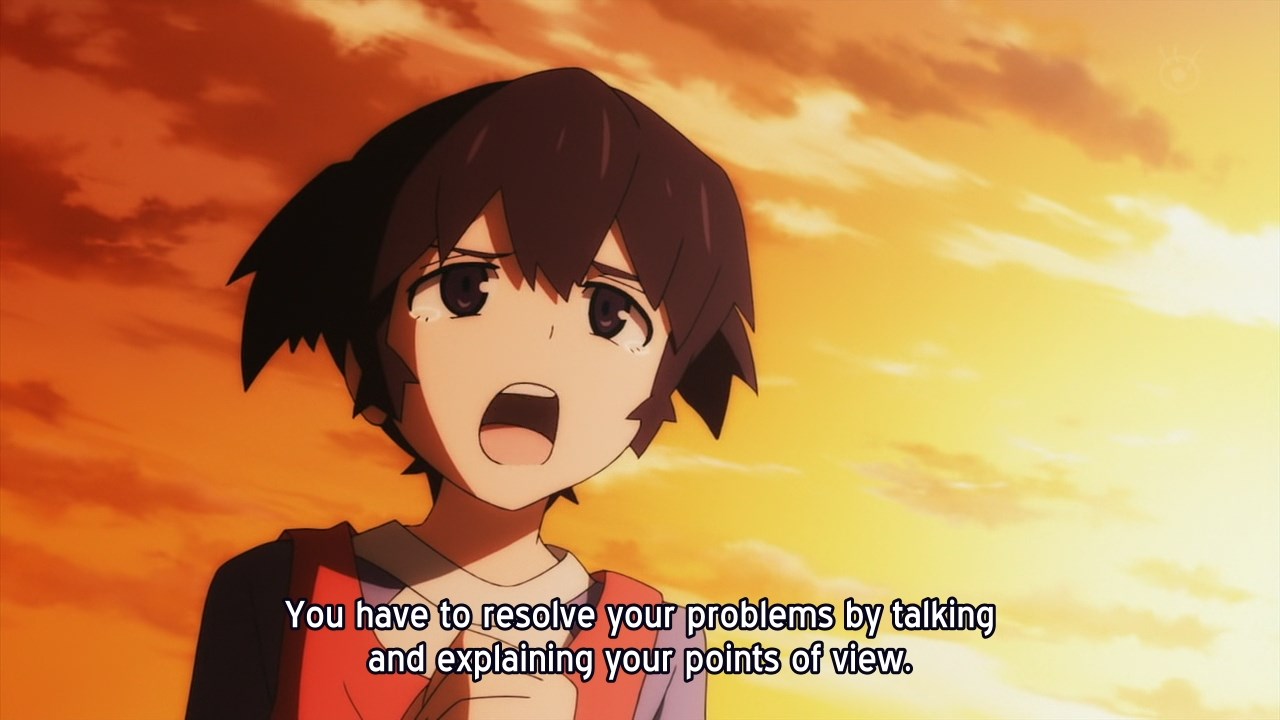
Mato telling it like it is

Yuuka learns from the 00 successors
So you would think from all of this talking, then there wouldn’t be any conflicts to start with, right? Well, that may be the case, unless you suffer from…
Lack of Self-understanding
Surprisingly often you’ll find that the main characters in Okada’s stories have the hardest time understanding themselves. While they share what they can with others, it’s often not enough, as they must first look within themselves to find the answer. However, the process to that is long and hard, and inevitably fraught with fear.
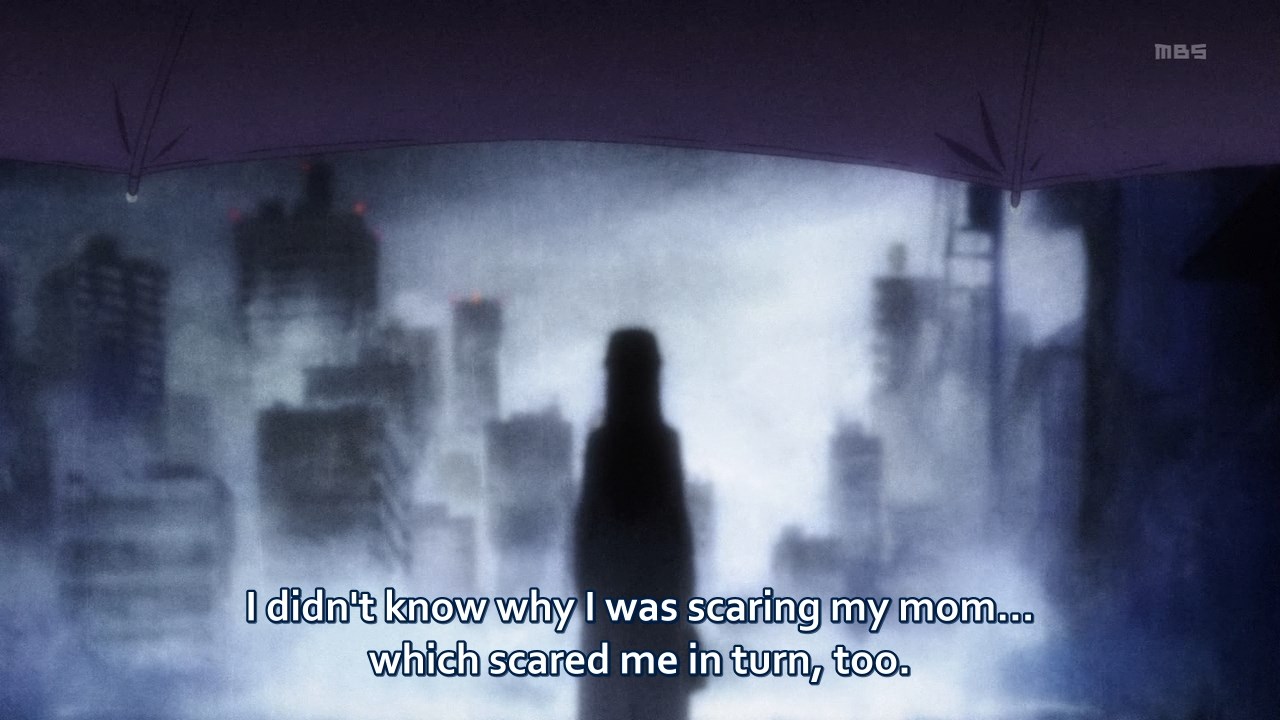
Nobody knows what Ruu is thinking, and that causes a spiral of fear
The climax of many of these stories comes when the main character has gone through a series of painful trials, which only then leads to them learning who they truly are. Art imitates reality, as only with our backs pushed against the wall do our true colors show.
At this point, I can say that I’ve already hit at the heart of why her writing is so incredible. Over the years, I’ve spoken with many people about why they love or hate Okada, and I believe that it all comes down to your own personal experiences in life. What kind of friends did you have? Did you have a boyfriend or girlfriend? Did you have a one-sided love, or were painfully dumped? Did you enjoy shallow but fun friendships, or did you like to have deep, meaningful talks about yourself or other members of your group? Perhaps you actually always wanted to have those talks, but never could. Maybe you can relate to not understanding yourself, whether that be you or someone you know, and either accept it or look back with scorn on how foolish you were and the mistakes you made. To me, every story and every character Okada writes is based firmly in reality—my reality. If even now you can’t understand her, then please try to open up and be more empathetic. A character is acting in a way that doesn’t make sense to you? Think about why that is, and what their feelings could be. Look at their expressions, try to see through the white lies they tell to protect themselves. Don’t ignore or attack perceived inconsistencies—think about why they were deliberately written in. Because it is intentional, and it is important. Perhaps if you still can’t, then what you’re lacking is…
Love
Love is everywhere. Love will save the world. There is no story Okada writes without love, and I mean that in both meanings. Sometimes it will be used as an underlying theme like in Fractale. Sometimes it drives the plot, like True Tears. Sometimes it’s used for the most heartwrenching scenes, like in AKB0048. And other times it’s Aquarion EVOL (protip: LRIG is GIRL backwards). The Otherworlders in BRS only act because they love their girls, and LRIGs in Wixoss often do the same. Though like everything, it’s not all rainbows and unicorns…
Losing your love is never a good thing. For the record, though some of you more familiar with her works might have this idea that there’s a lot of incest, there really isn’t. I legitimately looked for as much as I could find, and there wasn’t enough to even fill out a single slide. And yes, I’m fully aware of the lewd ex-sis.
Most importantly, Okada does not subscribe to the “one kind of love only” thing that some otaku love (ha ha) clinging to. Love is not simply limited to romantic love. There is love born of friendships and rivalries, of familial bonds, of admiration and inspiration. This is not actually so rare a concept, but in the wider anime fanbase you see people often completely misunderstand entire stories because they can’t discern the difference. If you got mad at the end of True Tears, and you rewatch it and you’re still mad (because you probably forgot the reason after all this time), then you’re probably one of these people.
Cliffhangers without Twists
One vital thing that pervades her compositions are that many if not most episodes will end with a cliffhanger, but this won’t be preceded by a plot twist. There will never be a “last ten seconds” twist to try and keep you coming back (I’m looking at you Aldnoah S2). It’s always a reasonable cliffhanger onset by events that happened leading up to the end, and you’ll never feel like you’ve been blindsided.
Birds and Symbolism
To be honest, I haven’t compared it to every single other anime out there, but pretty much all of her series include symbolic birds at some point. There are three important notable examples though. The least of them is Hanasaku Iroha, with the herons always getting in Ohana’s way and being used as a mirror for her emotional stability. Then there’s this:
Jibeta and Raigoumaru were used as analogs to Shin’ichirou, Noe, and Hiromi throughout the series, as well as being the main characters of Shin’s picture book. While I’m at it, I’ll skip ahead and mention that this also relates to the themes of flying and dreams throughout the show, plus the two girls are respectively represented by the colors red and white, also used constantly in symbolism. But the biggest example is this:
Black Rock Shooter uses the story of Kotori Asobi, the Bird at Play, constantly. It tells of a bird who flies around collecting the beautiful colors of the world, until it becomes overburdened, blackened, and dies. It’s also a reading of the name of Takanashi Yomi, the framing of the ED animation, and compared to why nobody understands Mato.
Friendship Bracelets
Almost literally everywhere. Sometimes rings, sometimes tattoos, sometimes scrunchies—Okada loves them. Despite the most famous example in BRS, it actually started with her first original series, Sasami.
![[RaX]Sasami_-_Magical_Girl_Club_-_08_-_Ring_of_Friendship_[x264_aac]_[5D700655].mkv_snapshot_22.47_[2016.03.22_19.20.53]](http://mezashite.net/wp-content/uploads/2016/04/RaXSasami_-_Magical_Girl_Club_-_08_-_Ring_of_Friendship_x264_aac_5D700655.mkv_snapshot_22.47_2016.03.22_19.20.53.jpg)
Bathroom Jokes
I was surprised that the famous Wixoss scene (below) actually had origins earlier on. Maybe Okada actually admired this strange girlish tradition and wanted to do it herself, so she lives it out through her anime.
I’ll take this point to also mention fanservice in her anime. And by fanservice, I mean nudity. I think I saw one “fanservicey” panty shot in all of the shows I rewatched combined, and I think it was back in True Tears. Every other time, it’s actually quite subdued, even refined. You’re more likely to see (“see”) full nudity when someone is taking a shower or bath than one of your generic “boy sees girl, girl slaps boy” scenes. Actually…

My god, a reasonable response?
This one scene actually indicates the complexities of Hiromi’s feelings and circumstances, and how much she has to hold back in her daily life. Okada makes liberal use of shared bathing scenes, fully believing in the idiom that baring your body relates to having nothing to hide, as mentioned earlier.
Properly Utilized Flashbacks
I had nothing snappy to connect this to the last point, but it is of vital importance to the enjoyability of her anime. You will almost never (at least never that I can recall) see a single, full flashback shown in its entirety the first time. You’ll always find out bits and pieces, and have to try and read between the lines to get the full picture before it’s revealed to you. The best example is Ano Hana.
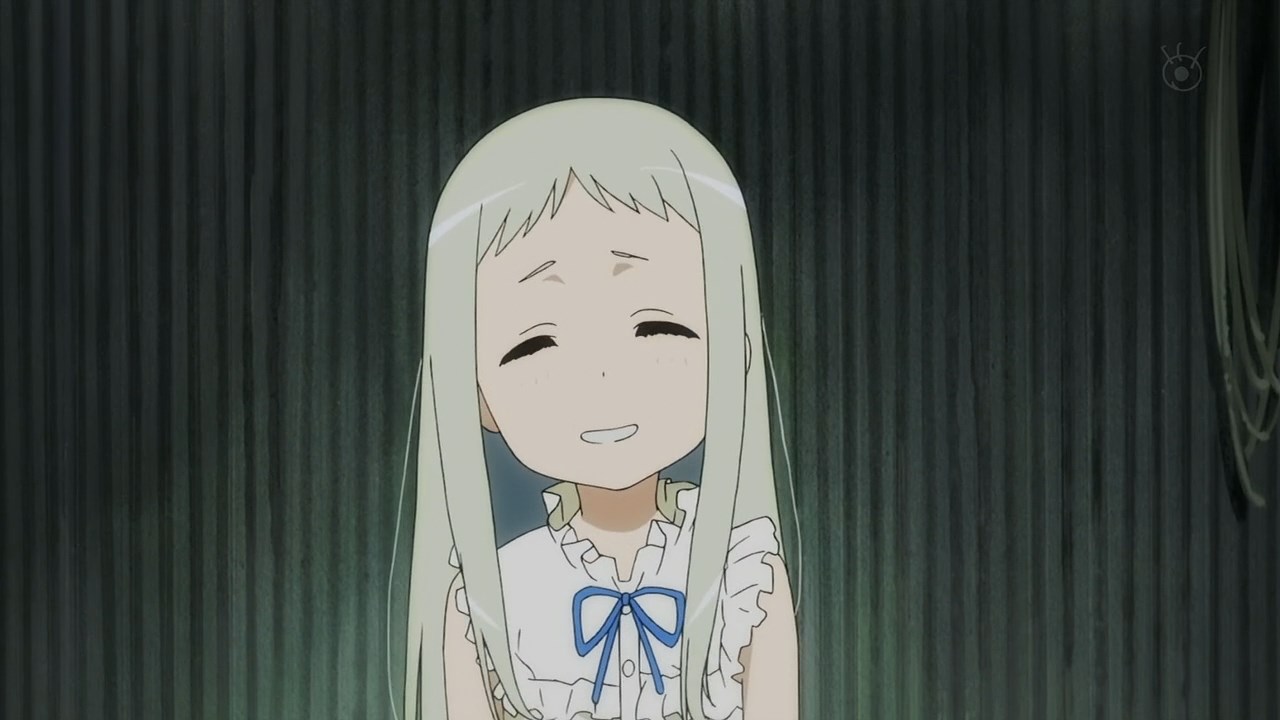
“Ugly”
You might not remember if you last saw it five years ago when it aired, but every single member of the Super Peace Busters has their own bit to add to the fateful day Menma died, and it’s slowly revealed from the very first up until the very last episode (seriously, Poppo only opens up in the last 12 minutes). In Wixoss as well you see this done incredibly, with Ruuko’s past with her mother told little by little, slowly showing why she’s so scary.
Subtleties and Implications
This was my longest run of slides, which is unfortunately almost all examples and not much to define. Okada is subtle. Here are a couple examples.
In episode 1 of Fractale, Phyrne sees a video of Clain as a baby with his parents. In episode 6, a strange man appears, has an antique house (Clain himself loves antiques), gets mistaken as pervert (like Clain), and in the end gives Clain a rare camera, a prized possession in this future dystopian age. It turns out this man was Clain’s estranged father, but this is never told to you. In fact, only Phyrne finds out, and she never tells Clain or the viewer. It’s left as perhaps the most depressing and sobering scene in the entire show, making you really feel how terrible the Fractale system is, rather than just seeing it in others.
Menma has rare flashbacks of Jinta’s mother from before she died (before they both died, rather), but can’t recall the words she was told. In episode 8, Jinta cries for the first time all series, and it’s then that we see this silent flashback, and Menma begins to cry herself. This is also when Menma starts to disappear. It’s only at the end of the final episode 11 where we hear what her last wish was, and that was to fulfill her promise to make Jinta cry. The reason she started to go away was because that was the moment her wish was granted. This, too, is never spelled out.
Chieri’s entire character in AKB. Over, and over, we’re shown her harsh love from Nagisa’s knowing perspective, and how she’s the strictest towards those she cares about. She won’t console you, but rather believes in you with all her heart that you can overcome your trial by yourself and become stronger. This is obvious from our outside, protagonist perspective. But when the tables turn and Chieri demands that Nagisa only quit after losing properly to her, we hesitate. After all, she’s always been kind to Nagisa/us. But this, too, is left as an exercise for the viewer to work through, to see through her facade to the love she has for Nagisa. She admits as much during the first cour finale. Actually, all of AKB has amazing moments like this, too many to list here.
![[Asenshi] selector infected WIXOSS - 01 [519D7369].mkv_snapshot_12.49_[2016.03.17_18.53.21]](http://mezashite.net/wp-content/uploads/2016/04/Asenshi-selector-infected-WIXOSS-01-519D7369.mkv_snapshot_12.49_2016.03.17_18.53.21.jpg)
Thank god I translated this correctly. This was some Ikuhara-level shit right here.
Music and Song
Almost every single series I reviewed had a meaningful song in it. Canaan, True Tears (roaches, anyone?), Fractale, NagiAsu. But three examples once again stand out.
![[UTW]_Ano_Hana_-_10_[h264-720p][EB5B74AD].mkv_snapshot_22.27_[2016.02.26_23.41.11]](http://mezashite.net/wp-content/uploads/2016/04/UTW_Ano_Hana_-_10_h264-720pEB5B74AD.mkv_snapshot_22.27_2016.02.26_23.41.11.jpg)
Ano Hana is a meta anime created from the song Secret Base by ZONE. The anime comes ten years after the song, which mirrors the lyrics themselves. It also starts in summer, has fireworks, letters, phone calls, and so on, all directly taken from the lyrics of the song. Plus it has the benefit of being one of the most nostalgia-inducing songs in all of Japanese pop culture.
Black Rock Shooter is, obviously, Black Rock Shooter. Every episode title is a lyric from it.
![[EveTaku] AKB0048 - 01 (BDRip 1080p H.264-Hi10P FLACx2)[2E466523].mkv_snapshot_02.18_[2016.03.23_20.09.44]](http://mezashite.net/wp-content/uploads/2016/04/EveTaku-AKB0048-01-BDRip-1080p-H.264-Hi10P-FLACx22E466523.mkv_snapshot_02.18_2016.03.23_20.09.44.jpg)
AKB0048 is the best. Just the best. Every single song is meaningful, and the episodes are written to incorporate them flawlessly. “I’ve been waiting” (Aitakatta) for the first song of concerts, Heavy Rotation to pick up heavy objects, Beginner for the Understudies’ first concert, Shonichi (First Day) for Kanata being reborn, Anti for haters, Heart-shaped Virus for infecting new idols, Pioneer for Chieri’s stand, Kaze ga Fuiteru (The Wind is Blowing) for the nuclear-level disaster of Akibastar. That’s not even half of them. But my favorite is this one:
Makoto, the normal and rather negative girl, is facing her fears and bungee jumping. But what’s this? She’s facing the wrong way! This is a pun in Japanese. Maemuki or Optimistic is literally “front-facing”, but she’s ushiromuki, which is Pessimistic, and literally “backwards-facing”. Afraid to face her fears, she turns around and jumps off backwards, perfectly encapsulating her character in a single action. And the song that suits her best is Boku dake no Value, “The Value Only I Have”.
Parallelisms
Both within single episodes and spread out across entire series, there will be events, conversations, and character developments that occur more than once for different people. Ohana’s reaction to identical text messages from her mother and Kou are like black and white, and the connection between Hikari and the Sea God runs far deeper than you might see at first. With a whole 15 episode gap between Nagisa and Chieri repeating the same line “I won’t be easy to beat”, this is one of the most well-paced examples, showing both their growth and how they’ve come to influence each other over nearly a year. This also shows up in smaller ways in how you’ll often see more than one scene running at the same time, with cuts back and forth between them. This adds together to make Okada-written episodes some of the most dense in terms of pure scene count that I’ve ever seen. The difference in my written notes between episodes she wrote and didn’t are incredibly obvious, case in point. Here’s my favorite example:
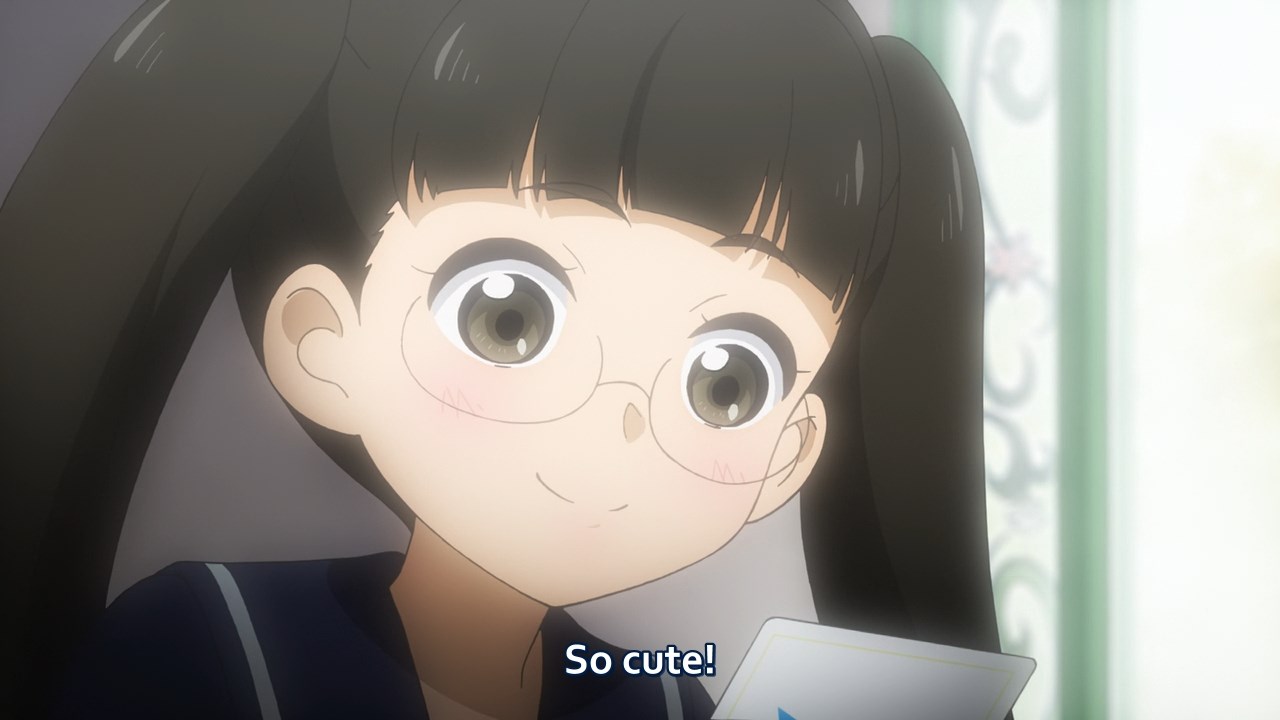
But Hitoe isn’t the only one who loved the library
Both Hitoe and Chiyori had no friends, and stayed alone in the very same library. They both started to change and get friends once getting their LRIGs. Both of their LRIGs came to regret being with their Selectors, because the last thing that both Midoriko and Eldora admit are that they loved Hitoe and Chiyori. It’s only appropriate that the one to put an end to Chiyori’s story is Hitoe, who had gone through the exact same experience.
Thematic Development
I should hope this one is obvious, as it’s one of the more clear things Okada does. Besides writing characters like a boss, she picks a theme and sticks through it until the very end. True Tears has flying and tears, with motifs of the storybook, chickens, and festival dance. Canaan has eyes, sight, vision, and perception, as well as colors. Fractale focuses on freedom, and the nature of man. Ano Hana, as well as many others, is all about change with a focus on what makes an adult, as all their time stopped when Menma died. There’s also the titular flower, the Forget-me-not. Hanasaku makes a distinction between ganbaru “to do your best” and Ohana’s made up word of bonboru, to “to your best for your wish”, and spends the last arc focusing on the distinction of purpose in life. Black Rock Shooter uses colors and honesty, but what’s really interesting is this:
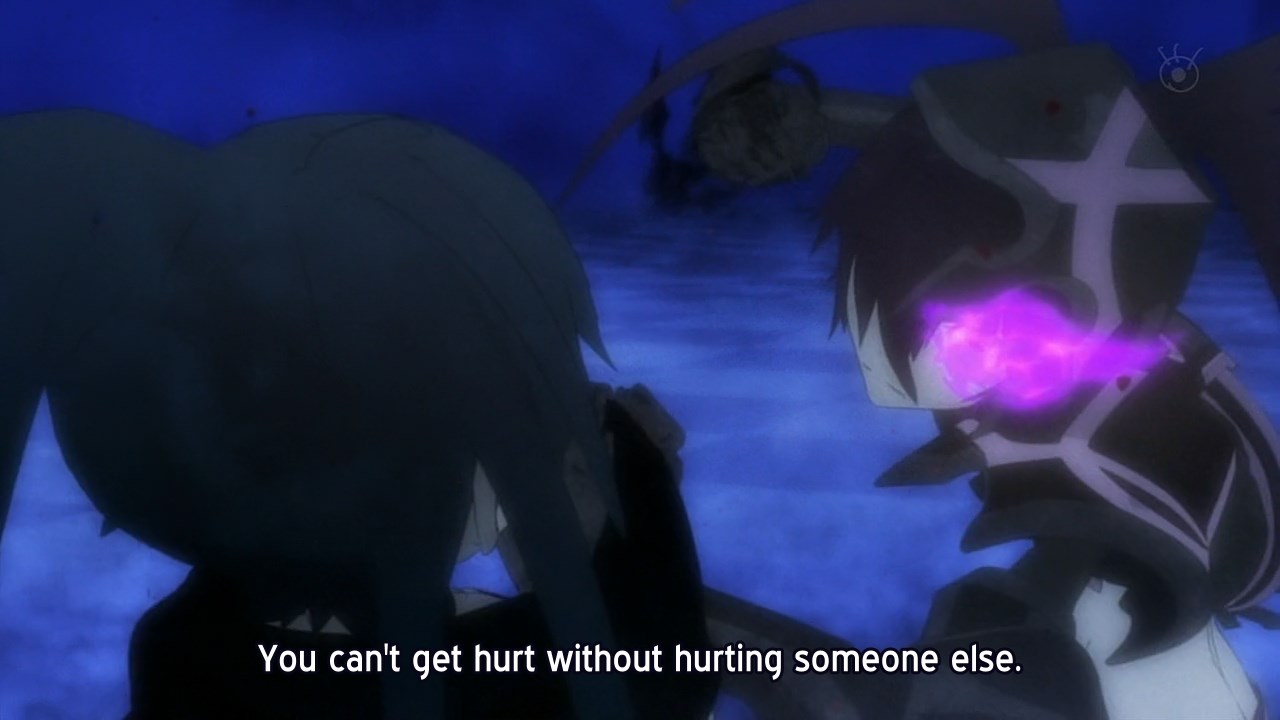
Now where have I seen this two days ago…
Pain. The theme of BRS is actually pain. Mato was running from her pain, and the entire purpose of the Otherworld avatars is to take your pain so you don’t have to suffer. But to make real connections, to be honest with others, you must learn to accept the pain of hurting others. It’s not about others hurting you—that’s just not understanding them. It’s not about simply hurting others—it’s understanding that when you hurt others, you yourself are also hurt, and you mustn’t run from that pain. The last thing MatoRS resolves to do is hurt IBRS, and thus to connect with her inner feelings.
The list just goes on and on. You can’t watch NagiAsu without seeing what happens when change is forced upon you, and also what happens when you can’t run away. Wixoss is littered with card metaphors, both in the language and the visuals. Plus it also benefits from colors as well. Mayu is shown as being made up of only black and white, of being isolated from the outside world. In the end, however, it’s shown that her heart is colorless. Is that the color of the emptiness and loneliness she felt in life? No, it’s the beginning of all things, a blank canvas for her to start anew, as a single rainbow butterfly comes from within the fluttering of countless black and white ones from her past life.
![[Asenshi] selector spread WIXOSS - 12 [665A0C32].mkv_snapshot_17.09_[2016.03.24_01.06.37]](http://mezashite.net/wp-content/uploads/2016/04/Asenshi-selector-spread-WIXOSS-12-665A0C32.mkv_snapshot_17.09_2016.03.24_01.06.37.jpg)
Inter-series Similarities
Canaan makes a blatant 12,000 year reference to Aquarion. You’re more likely to remember Akira kicking the hostage Hitoe before being kneed by Uliona, but you’re less likely to remember that an identical scene happened between Liang, Maria, and Alphard in Canaan. That confession scene in Ano Hana occurs almost line for line in NagiAsu. Kirito in Hanasaku (yes, Kirito, voiced by the SAO guy and named the same thing years before the anime) gets rejected by the girl he likes, only to get his revenge, once again voicing an important side character, by dumping a girl in BRS. The shadowlessness of Strength in BRS comes back with Menma in Ano Hana. Or maybe the reverse. Here’s the best one though:
![[Asenshi] selector infected WIXOSS - 11 [E91C9E0C].mkv_snapshot_12.12_[2016.03.18_22.25.06]](http://mezashite.net/wp-content/uploads/2016/04/Asenshi-selector-infected-WIXOSS-11-E91C9E0C.mkv_snapshot_12.12_2016.03.18_22.25.06.jpg)
A girl who nobody can understand. A mother who feels she’s trying to grow up too quickly, and scares her. A friend associated with the color green who loses her memories of her friends, and who feels physical pain whenever she remembers them. And a girl with white hair who’s horrified of reality and sends out an avatar of herself into the real world to do her bidding. I bet you can’t tell which series I’m talking about, because both Wixoss and BRS have identical plotlines following this story flow.
Other Writers
I didn’t develop this section as much due to time constraints, but I figured I’d at least mention some things I intended to include. In a True Tears interview, we hear that Okada for that series exercised heavy control over the other two scriptwriters, but later felt bad about it. Thus begins her style of composition, of allowing other writers more control over their episodes. This, unfortunately, leads to some weird inconsistencies.
In Fractale, Clain is obsessed with antiques. So much that he’s happy to be staring down the barrel of an old gun. But in one episode when he’s feeling particularly down, he suddenly hates old-fashioned things. There is no way this was intended to be the case, as it’s quickly forgotten. Same with Phyrne and Nessa. Okada wrote an episode where they become close and hold hands (notable since only people who like Nessa can do so), yet the next episode she didn’t write we see Phyrne hesitant to do the same thing.
Nako in Hanasaku has some strange episodes between the cour 1 climax and her focus episode in 17 or 18. We see her being particularly open and not shy around others, so that during Okada’s stint it feels like Nako’s a totally different character when she becomes shy again, unable to even speak properly to guests at her job, saying she’s not comfortable anywhere outside her home.
In NagiAsu, Miuna falls in love with Hikari when he saves her from drowning, but the form her crush and personality takes is all over the place when other writers show up. Is she too embarrassed to speak to him or look at his face? Does she cling obsessively to his sleeve? Is she aggressive? She’s like a superball flying around randomly. Then there’s the strange case of Hikari being extra haughty in two school introduction scenes, one before and one after the time skip. Assuming shenanigans I checked the writers, and as it turns out the same guy did both of those strange episodes with his weird concept of Hikari’s personality.
That 42 second flashback in Wixoss of the Oath scene immediately after it happens to Yuzuki? That wasn’t Okada’s episode. And all of the comparatively soulless episodes in Spread 3-8 weren’t her either. It’s unbelievable how good Spread is episodes 9-12 after the lacking middle part, so much that I feel bad defending it. I won’t stop doing so, of course. It has some of the best thematic writing in all of Okada over both seasons.
And I can’t finish this off without mentioning Glasslip. Hey, what if the same director as True Tears, same studio, same chickens, and same still shots get reused without Okada? Surely it’ll be as good as True Tears. But no, it was a colossal failure. If there’s any example to show how vital she is to creating anime, it’s right here. What a mess that was.
Thanks for sticking through this with me until the end. I was able to both summarize and include more info than what’s in the video above, and finally get this publicly available. Have you all seen Kiznaiver yet? I had the privilege of seeing episodes 1 and 2 early thanks to Crunchyroll, and nothing could confirm how accurately I’ve gotten the science of Okada down than proving it with a totally new series of hers and seeing almost every single point I made above being shown one after the other. It was almost scary seeing how perfectly I could’ve predicted what happened. See for yourself, if you’re interested.
4/13: I just got a nice Pingback from Justin on Onna no Kantoku with a much more well-thought out and composed article also about Okada that I recommend. Though from the notes he’s also had more time to process his data, and probably didn’t sit down to write this in one spurt from 9 pm until nearly 3 in the morning like I did. I just prefer getting it all out at once while the spark is still burning.
4/16: Cool translated interviews with Okada about Kiznaiver and Mayoiga here. I myself will be checking out some of the others to save myself the effort of translating them as I get more info that I missed before.


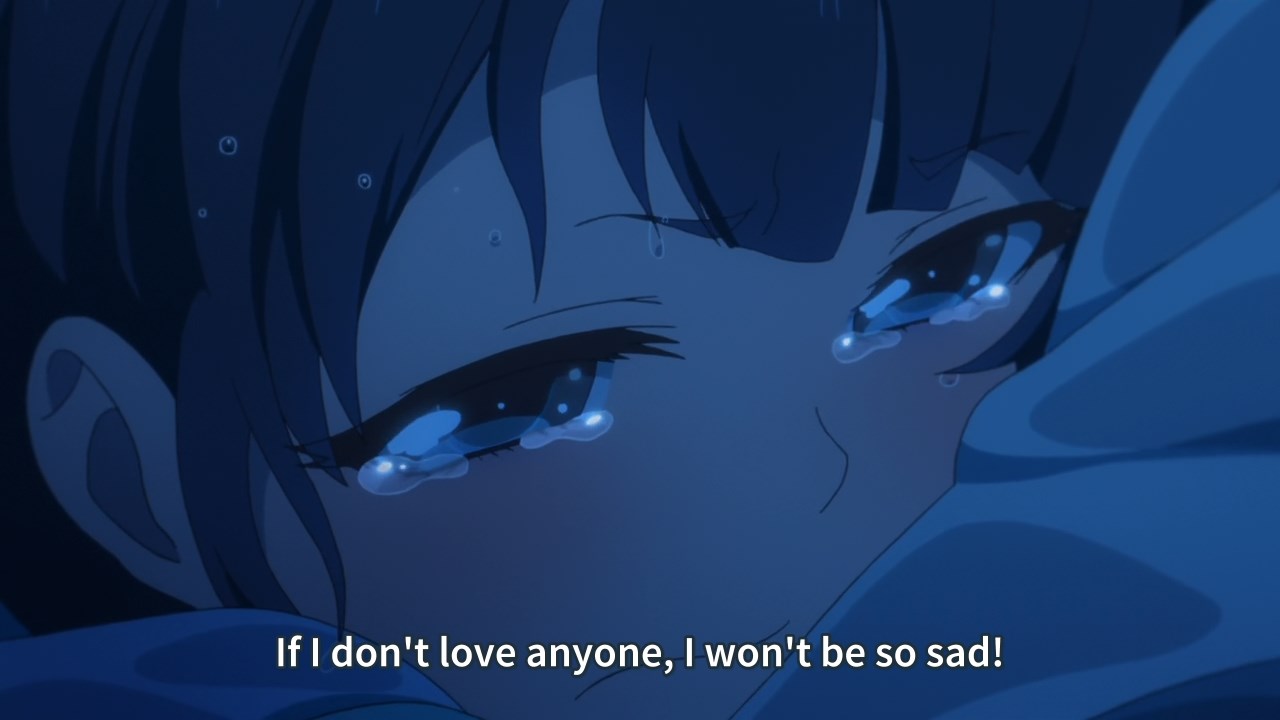
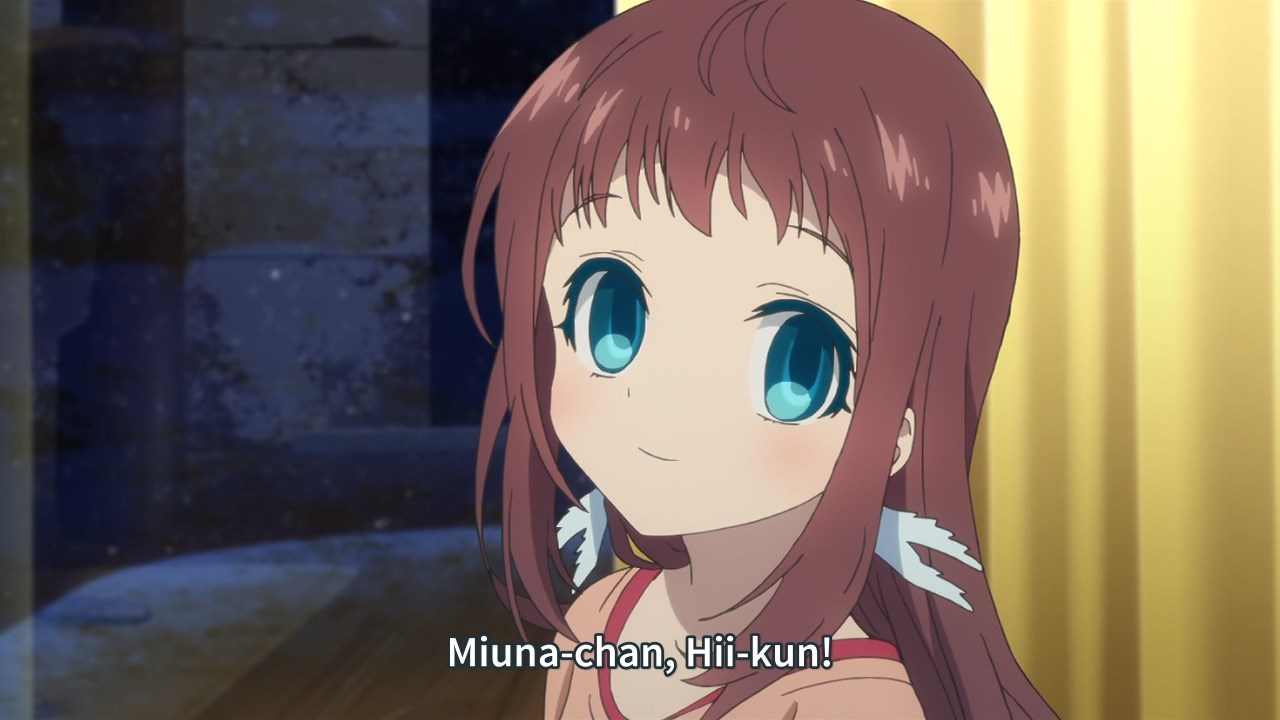
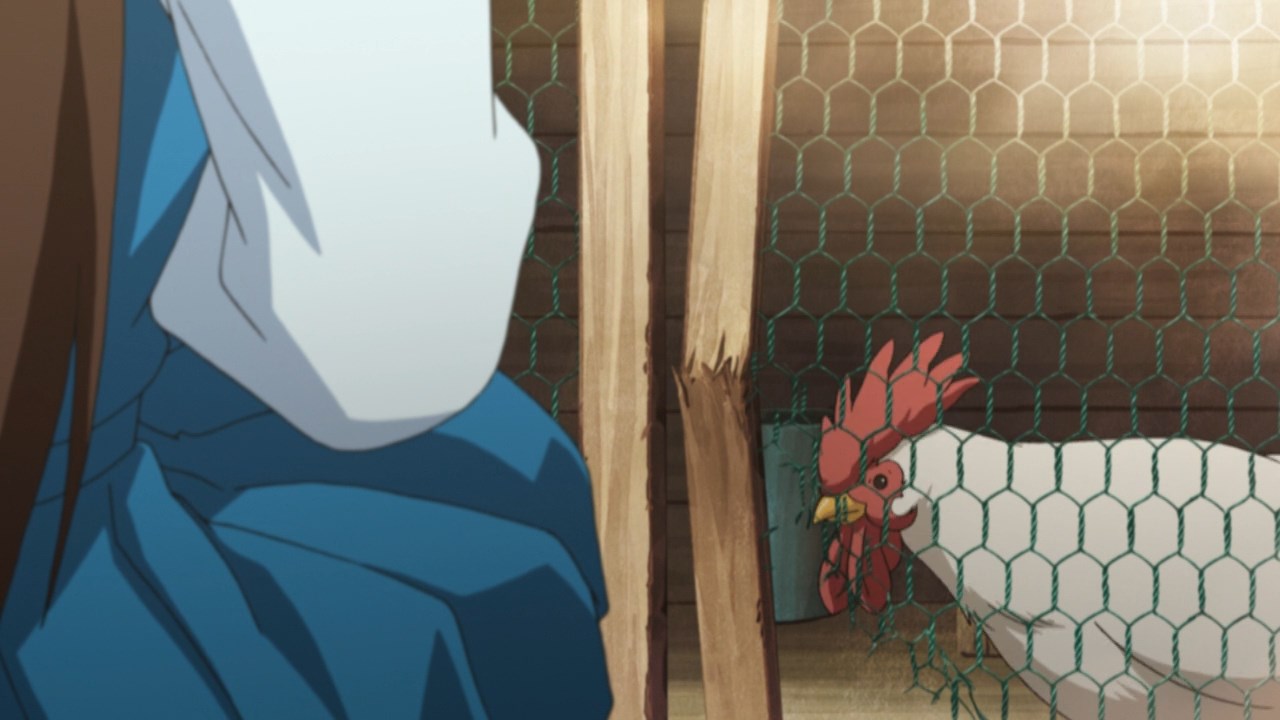
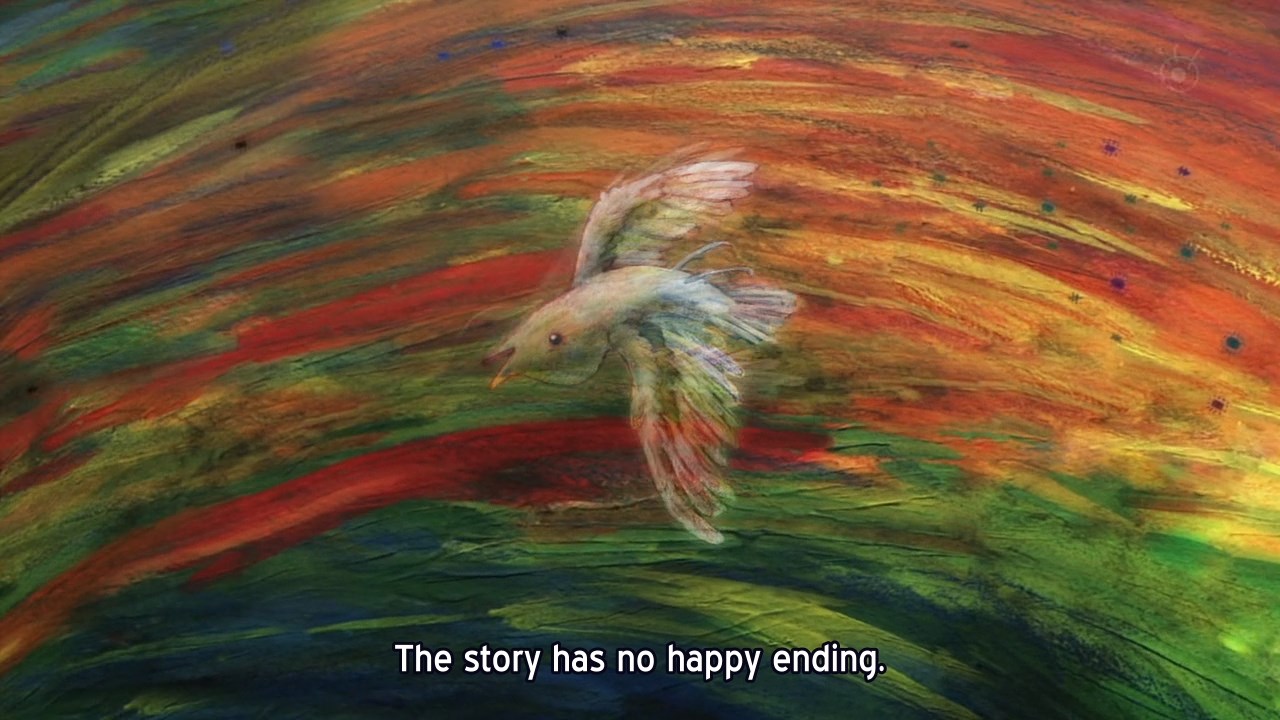
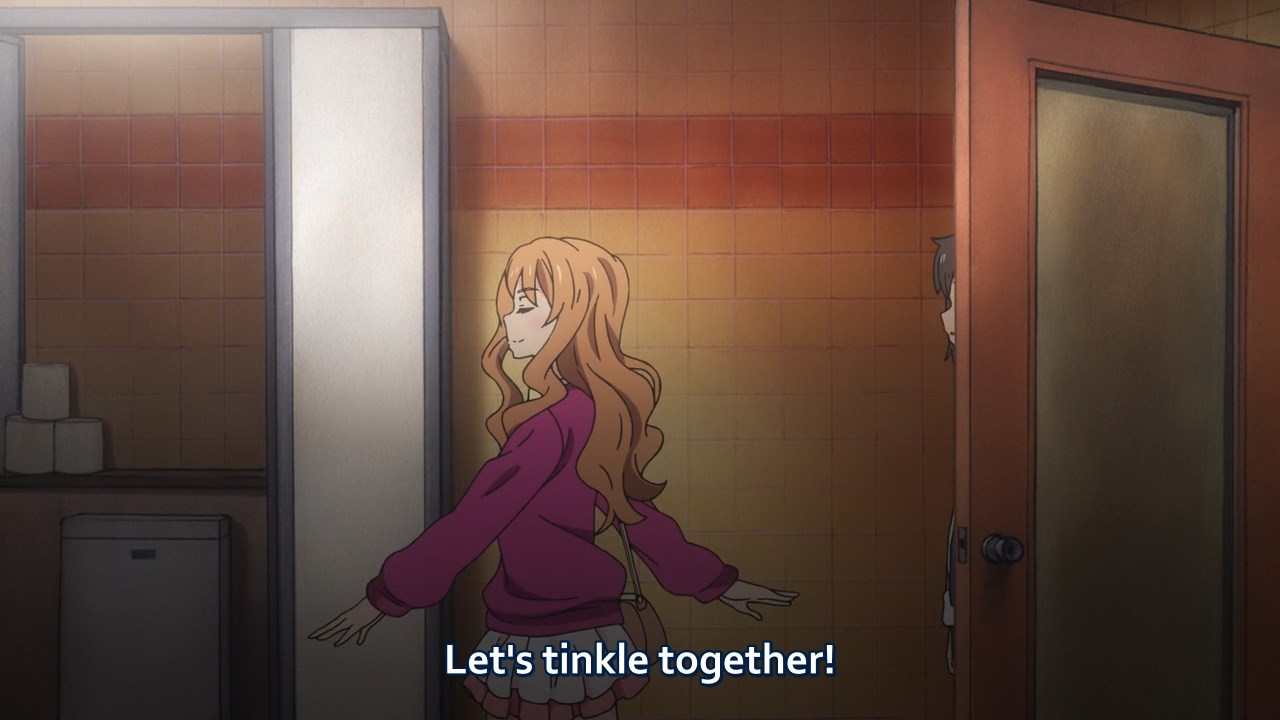
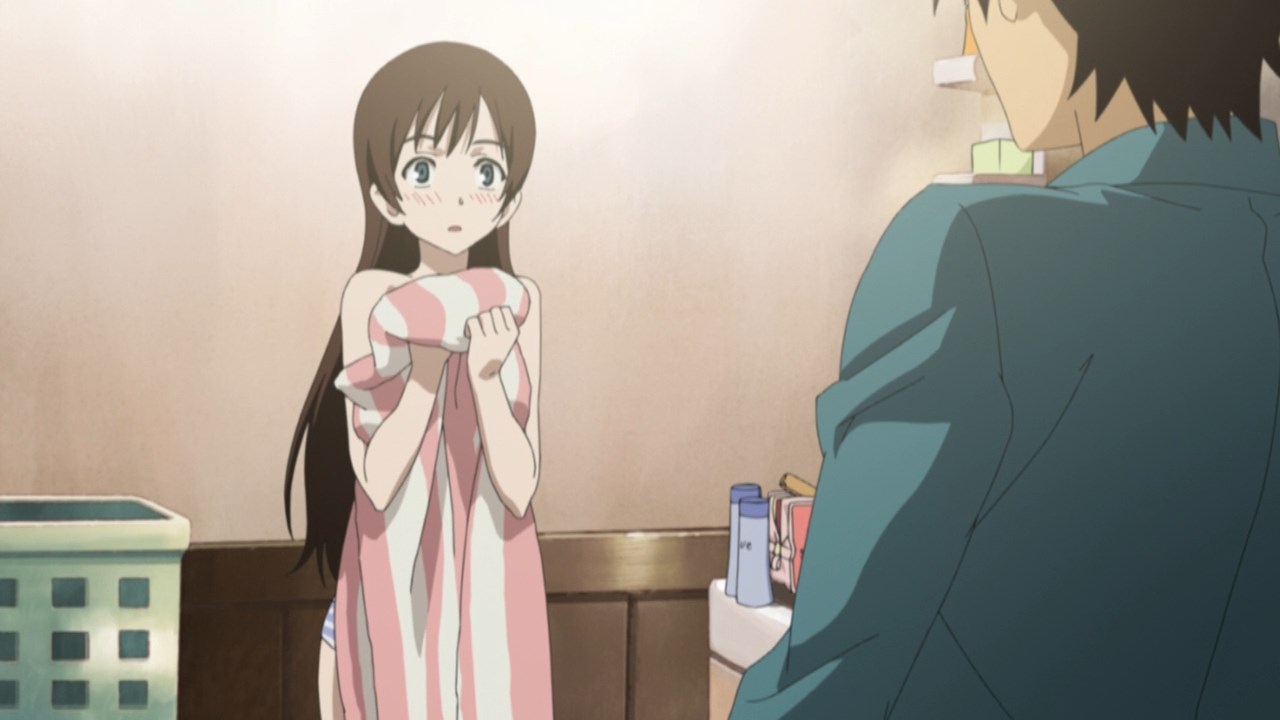
![[UTW]_Fractale_-_06_[BD][h264-720p][FLAC][8F413339].mkv_snapshot_20.42_[2016.03.23_14.55.38]](http://mezashite.net/wp-content/uploads/2016/04/UTW_Fractale_-_06_BDh264-720pFLAC8F413339.mkv_snapshot_20.42_2016.03.23_14.55.38.jpg)
![[UTW]_Ano_Hana_-_07_[h264-720p][C0AD269B].mkv_snapshot_06.24_[2016.03.23_17.10.53]](http://mezashite.net/wp-content/uploads/2016/04/UTW_Ano_Hana_-_07_h264-720pC0AD269B.mkv_snapshot_06.24_2016.03.23_17.10.53.jpg)
![[EveTaku] AKB0048 - 06 (BDRip 1080p H.264-Hi10P FLAC)[45DA675F].mkv_snapshot_08.26_[2016.03.10_18.49.13]](http://mezashite.net/wp-content/uploads/2016/04/EveTaku-AKB0048-06-BDRip-1080p-H.264-Hi10P-FLAC45DA675F.mkv_snapshot_08.26_2016.03.10_18.49.13.jpg)
![[WhyNot] Black Rock Shooter - 03v2 [C9195F8D].mkv_snapshot_02.25_[2016.03.23_19.16.13]](http://mezashite.net/wp-content/uploads/2016/04/WhyNot-Black-Rock-Shooter-03v2-C9195F8D.mkv_snapshot_02.25_2016.03.23_19.16.13.jpg)
![[FFF] AKB0048 - 18 [BD][720p-AAC][BE2D5802].mkv_snapshot_19.43_[2016.03.12_21.53.37]](http://mezashite.net/wp-content/uploads/2016/04/FFF-AKB0048-18-BD720p-AACBE2D5802.mkv_snapshot_19.43_2016.03.12_21.53.37.jpg)
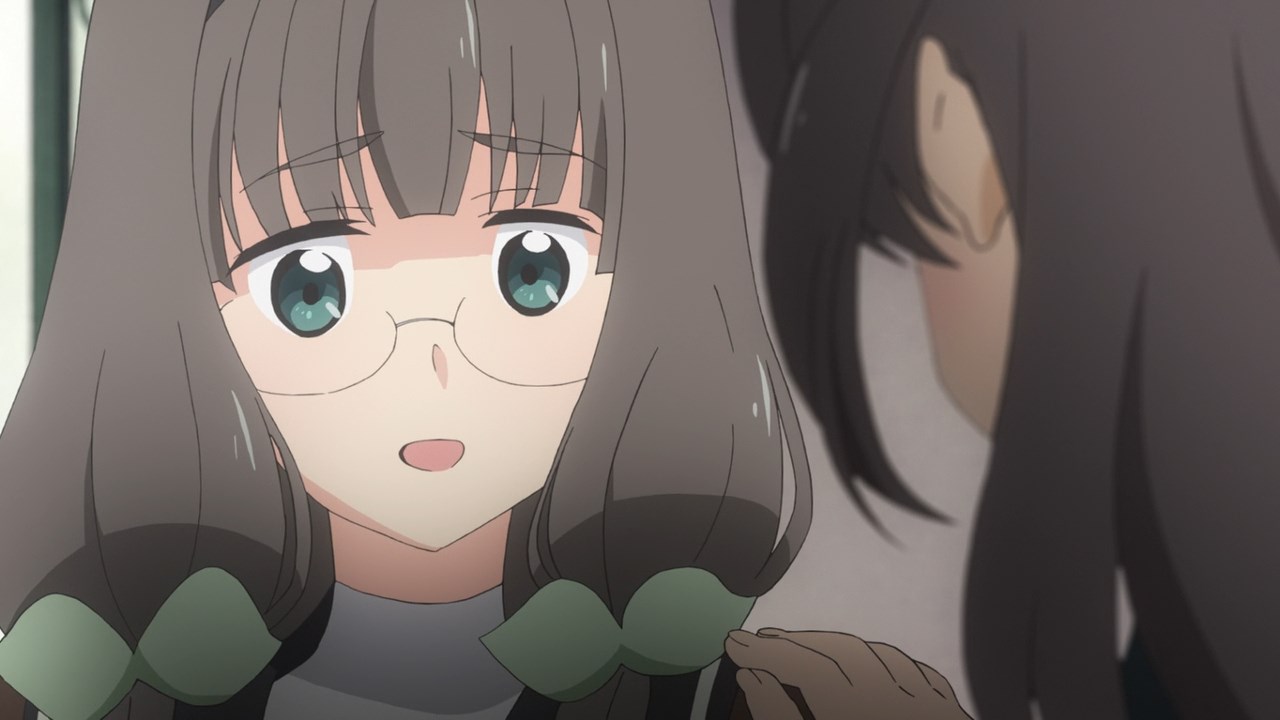
![[WhyNot] Black Rock Shooter - 07 [60DD230C].mkv_snapshot_08.32_[2016.03.09_00.04.43]](http://mezashite.net/wp-content/uploads/2016/04/WhyNot-Black-Rock-Shooter-07-60DD230C.mkv_snapshot_08.32_2016.03.09_00.04.43.jpg)
![[Underwater-Vivid] Nagi no Asukara - 15 (720p) [B29B98F2].mkv_snapshot_21.21_[2016.03.15_23.12.36]](http://mezashite.net/wp-content/uploads/2016/04/Underwater-Vivid-Nagi-no-Asukara-15-720p-B29B98F2.mkv_snapshot_21.21_2016.03.15_23.12.36.jpg)
Pingback: Kiznaiver — 01 | Asenshi Subs
Pingback: Kiznaiver — 01 | Asenshi Subs
Wew lad, I have to say I was never thinking that deeply about those shows when I watched them, but I did enjoyed the hell out of BRS, AKB0048, Wixoss and IBO. Haven’t watched most of the others but perhaps I should pick them up. Kinda stopped somewhere in the middle for Nagi though.
Interesting rant post though, I had fun reading it.
Wew lad, I have to say I was never thinking that deeply about those shows when I watched them, but I did enjoyed the hell out of BRS, AKB0048, Wixoss and IBO. Haven’t watched most of the others but perhaps I should pick them up. Kinda stopped somewhere in the middle for Nagi though.
Interesting rant post though, I had fun reading it.
That was a great read, I appreciate the efforts put in here, I haven’t watched a few up anime up there, but every single one I did, I loved… although I never knew it was the same person who did the writing… now I know.
It was a deep insights, glad to have read it to know more.
That was a great read, I appreciate the efforts put in here, I haven’t watched a few up anime up there, but every single one I did, I loved… although I never knew it was the same person who did the writing… now I know.
It was a deep insights, glad to have read it to know more.
A most interesting read, indeed! I must admit I’ve never dreamed of looking further than characters and seiyuu with regards to anime, so this was really new and insightful. I do plan on eventually re-watching AKB0048, and hopefully the second time around I’ll have learned a bit from you how to appreciate more of the writing in the series. Thank you for sharing!
A most interesting read, indeed! I must admit I’ve never dreamed of looking further than characters and seiyuu with regards to anime, so this was really new and insightful. I do plan on eventually re-watching AKB0048, and hopefully the second time around I’ll have learned a bit from you how to appreciate more of the writing in the series. Thank you for sharing!
Wew lad. I’m glad you like her so much, because I really can’t.
I know what you mean, of all the ones listed here, the only one Ive watched all the way thru was akb. I admit I really liked that one, but the rest, it wasnt that I hated them, but I just couldnt get into them.
Before this, I didnt know that she had written all of them, so I cant say it was any sort of bias against her tho. I dont usually pay much attention to the production side of things. Even with VAs I dont remember names, mostly it will be if I happen to notice a familiar voice.
Wew lad. I’m glad you like her so much, because I really can’t.
I know what you mean, of all the ones listed here, the only one Ive watched all the way thru was akb. I admit I really liked that one, but the rest, it wasnt that I hated them, but I just couldnt get into them.
Before this, I didnt know that she had written all of them, so I cant say it was any sort of bias against her tho. I dont usually pay much attention to the production side of things. Even with VAs I dont remember names, mostly it will be if I happen to notice a familiar voice.
I just clicked the video for a moment and find funny you used the image I extracted from a pixiv fanart from back 2014’s threads, so in some way part of me was there at your presentation may not in physical form but in spirit.
You really Digged depper with Okada this time (what a great job!) and I’m pretty much happy with your entire essay-esque writing because at least I got to confirm some of my own beliefs about Mari Okada’s writing style in which you managed to express them easily (I really hope all the time you invested on this meets a proper revenue in whatever form).
SincE I watched Hanasaru Iroha, Nagi no Asukara, WIXOSS and M3: Sonno Kuroki Hagane I realized there was a pattern in her writing but at the same time inconsistencies in terms of scriptwriting. The first clue was she not being the scriptwriter in some episode, but not only that, one could feel through a whole episode if Okada has done the script. Thanks reveal the truth about True Tears’s production which I got it complety wrong, it was not Okada who was forced, but the scriptwriters who were in Okada’s control and explains her current relationships with being the scriptwriter. Yet, I would like to remind you Okada does perrmit creativity freedom not only for the scriptwriters, but also the storyboarders (obviously, when she is the scriptwriter) according to some interview.
There is alsO something I’d like to add for future researching and it’s about related to Okada herself. I’m pretty much sure you know about how she often self-insert her former herself in her series. Yes, I’m talking abou Hiromi, Tsuruko and most likely the new Mako from Kiznaiver or sometimes she adds herself as someone she wanted to become like Noe, Mahmu, perhaps Mayu or the new one Nico. Also, how does the story composition affects the character design, there cannot be coincidence with the Yomi, Hitoe and Mahmu, just to point two stuff by now.
In aNy case, it’s was a cool reading and I can’t wait to dig further because I feel like rewatching and watching some series I left behind. But after all of this there is no way I can leave the Mari Okada Bingo I’ve done recently intact, it needs to be corrected. Thank you so much!
I just clicked the video for a moment and find funny you used the image I extracted from a pixiv fanart from back 2014’s threads, so in some way part of me was there at your presentation may not in physical form but in spirit.
You really Digged depper with Okada this time (what a great job!) and I’m pretty much happy with your entire essay-esque writing because at least I got to confirm some of my own beliefs about Mari Okada’s writing style in which you managed to express them easily (I really hope all the time you invested on this meets a proper revenue in whatever form).
SincE I watched Hanasaru Iroha, Nagi no Asukara, WIXOSS and M3: Sonno Kuroki Hagane I realized there was a pattern in her writing but at the same time inconsistencies in terms of scriptwriting. The first clue was she not being the scriptwriter in some episode, but not only that, one could feel through a whole episode if Okada has done the script. Thanks reveal the truth about True Tears’s production which I got it complety wrong, it was not Okada who was forced, but the scriptwriters who were in Okada’s control and explains her current relationships with being the scriptwriter. Yet, I would like to remind you Okada does perrmit creativity freedom not only for the scriptwriters, but also the storyboarders (obviously, when she is the scriptwriter) according to some interview.
There is alsO something I’d like to add for future researching and it’s about related to Okada herself. I’m pretty much sure you know about how she often self-insert her former herself in her series. Yes, I’m talking abou Hiromi, Tsuruko and most likely the new Mako from Kiznaiver or sometimes she adds herself as someone she wanted to become like Noe, Mahmu, perhaps Mayu or the new one Nico. Also, how does the story composition affects the character design, there cannot be coincidence with the Yomi, Hitoe and Mahmu, just to point two stuff by now.
In aNy case, it’s was a cool reading and I can’t wait to dig further because I feel like rewatching and watching some series I left behind. But after all of this there is no way I can leave the Mari Okada Bingo I’ve done recently intact, it needs to be corrected. Thank you so much!
Pingback: A Decade of Mari Okada – 女のカントク
Pingback: A Decade of Mari Okada – 女のカントク
It’s a nice coincidence that these happened to get published around the same time. I really enjoyed reading this. I know I’m definitely not really capable or piecing together the different threads that make of Okada’s writing style, even if I had the stamina to sit through and take notes on every episode. And you definitely put together a lot of the things that I really like about Okada’s stories that I wasn’t able to grasp. I think both of our posts really complement each other.
The research you did is outside my usual experience, and I find it hard to trust info without solid sources, especially links without Japanese original sites. Plus I had fun rewatching everything. Yeah, funny coincidence we finished within 48 hours of each other. I’m impressed you found this though, unless you had already known it was coming from the few places I mentioned it.
Oh I had no idea you were working on this or your panel at Anime Boston. Someone on twitter just happened to ping me (and a few other Okada fans) with a link the day you posted it.
It’s a nice coincidence that these happened to get published around the same time. I really enjoyed reading this. I know I’m definitely not really capable or piecing together the different threads that make of Okada’s writing style, even if I had the stamina to sit through and take notes on every episode. And you definitely put together a lot of the things that I really like about Okada’s stories that I wasn’t able to grasp. I think both of our posts really complement each other.
The research you did is outside my usual experience, and I find it hard to trust info without solid sources, especially links without Japanese original sites. Plus I had fun rewatching everything. Yeah, funny coincidence we finished within 48 hours of each other. I’m impressed you found this though, unless you had already known it was coming from the few places I mentioned it.
Oh I had no idea you were working on this or your panel at Anime Boston. Someone on twitter just happened to ping me (and a few other Okada fans) with a link the day you posted it.
nice read but it would be nice if u had the video for your other panel too coz i was curious bout that.
nice read but it would be nice if u had the video for your other panel too coz i was curious bout that.
Pingback: Kiznaiver and Mayoiga: Okada Mari in Spring 2016 | HOT CHOCOLATE IN A BOWL
Pingback: Kiznaiver and Mayoiga: Okada Mari in Spring 2016 | HOT CHOCOLATE IN A BOWL
This was excellent to read through. I love Mari Okada as well and it’s great to have even more depth to it. Please keep this article is an easy to find place forever.
A bit late now, but I had wanted to actually drop by properly.
Just wanted to say thanks and good work on such an informative post. I have personally only seen about one third of the stuff that Okada has worked on (and probably never will see all of them), so this kind of extensive write-up is really helpful. I’ll probably have to refer to it again as I keep reading the Okada-related interviews that I’ve found.
I also really liked how you had a summary of what’s involved in the ‘writing process’ at the start. In my own experience in discussions online, very few people understand this process well enough to offer a reasonable critique on what writers/series composers like Okada do in the shows they work on. The only little caveat I’d add is that, based on everything I’ve read, the director and the series composer usually decide the flow and key plot points/scenes of each episode together (though a few other people, usually producers, the production manager tend to be involved in those discussions too). The details (and any linking scenes etc) are typically left to the scriptwriter.
In any case, thanks again for posting such an extensively researched comparison!
A bit late now, but I had wanted to actually drop by properly.
Just wanted to say thanks and good work on such an informative post. I have personally only seen about one third of the stuff that Okada has worked on (and probably never will see all of them), so this kind of extensive write-up is really helpful. I’ll probably have to refer to it again as I keep reading the Okada-related interviews that I’ve found.
I also really liked how you had a summary of what’s involved in the ‘writing process’ at the start. In my own experience in discussions online, very few people understand this process well enough to offer a reasonable critique on what writers/series composers like Okada do in the shows they work on. The only little caveat I’d add is that, based on everything I’ve read, the director and the series composer usually decide the flow and key plot points/scenes of each episode together (though a few other people, usually producers, the production manager tend to be involved in those discussions too). The details (and any linking scenes etc) are typically left to the scriptwriter.
In any case, thanks again for posting such an extensively researched comparison!
This was such a great read! It really helped me to understand just why I enjoy her writing so much. Funny you mentioned Kiznaiver, because I was mentally ticking some check marks for every point that applies to it. I’d be really interesting to hear your take on it!
This was such a great read! It really helped me to understand just why I enjoy her writing so much. Funny you mentioned Kiznaiver, because I was mentally ticking some check marks for every point that applies to it. I’d be really interesting to hear your take on it!
Great essay. Now you only have to watch Simoun. I firmly believe that it’s Okada’s pinnacle of writing. Also, the show’s director is Nishimura. They always make such a strong combo when working together.